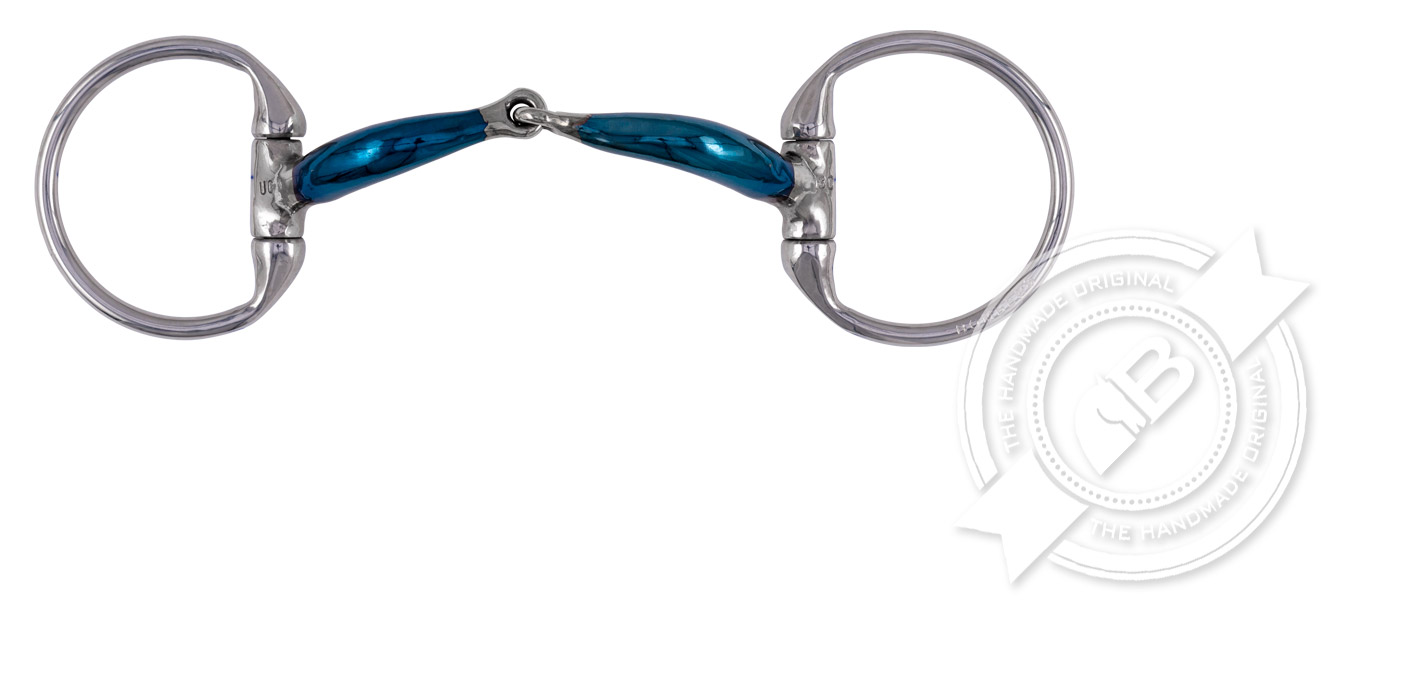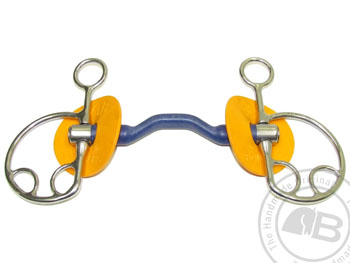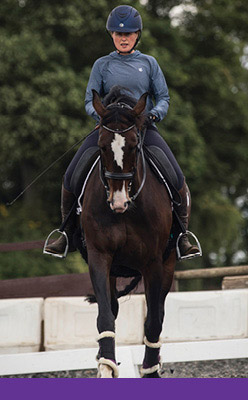Wearing of horse bits occurs due to the mechanical action of the bit. All horse bits will experience some wear if they are used, so it’s very important to regularly check your equipment, to ensure it is safe to use.
Metal bits
 Metal materials can experience wear when the bit is jointed (eg. a single jointed traditional snaffle, like the Bombers Eggbutt Snaffle Ultra Comfy, pictured left).
Metal materials can experience wear when the bit is jointed (eg. a single jointed traditional snaffle, like the Bombers Eggbutt Snaffle Ultra Comfy, pictured left).
Or, where there is movement (eg. loose ring bits, where the cheek piece ring slides through the mouthpiece, for mobility, like the Bombers Loose Ring Happy Tongue, pictured below-right). 
Wear occurs due to the friction between parts; when one metal part rubs against another metal it will create wear, as they are both strong substances – this can allow the joints to deteriorate, causing wear.
Non-metal bits
 Non-metal materials, such as the Bomber Blue Kimblewick from Bombers, pictured left, can also experience wear, as they are not as durable as metal materials.
Non-metal materials, such as the Bomber Blue Kimblewick from Bombers, pictured left, can also experience wear, as they are not as durable as metal materials.
Wear can originate from a horse biting into the material, or grinding it’s teeth on the bit. These non-metal materials are chewable, and a horse has a bite strength of 500 psi! But it is not just the force of the bite; the horse will grind, as well as biting down.
When this happens, the material is damaged and can let in moisture from the horse’s saliva.
Bombers’ non-metal bits all have a metal cable running through the centre to ensure the horse cannot bite the bit in half.
However, when the outer material is damaged, moisture is able to get through, potentially allowing the cable inside to wear.
Functionality
 The functionality of the horse’s bit can impact the wearing. If we compare a single jointed mouthpiece, such as the Bombers Eggbutt Snaffle Ultra Comfy, pictured top left, to a barrel jointed mouthpiece, such as the Bombers Loose Ring Waterford Barrel, pictured right, the barrel jointed mouthpiece will experience wear quicker than a single jointed mouthpiece.
The functionality of the horse’s bit can impact the wearing. If we compare a single jointed mouthpiece, such as the Bombers Eggbutt Snaffle Ultra Comfy, pictured top left, to a barrel jointed mouthpiece, such as the Bombers Loose Ring Waterford Barrel, pictured right, the barrel jointed mouthpiece will experience wear quicker than a single jointed mouthpiece.
This is due to the different joints – a barrel jointed mouthpiece experiences more wear as the joint is smaller, finer and goes through more friction. A single jointed mouthpiece is not experiencing as much friction, and is not as closely linked.
Usage of the horse bit
 The usage of a bit can also contribute to its wearing, depending on how often the bit is used and the level of work the bit is used for.
The usage of a bit can also contribute to its wearing, depending on how often the bit is used and the level of work the bit is used for.
When a bit is used very regularly for engaging work, as demonstrated left by dressage rider Bert Sheffield, it will experience wear as it will constantly be experiencing friction.
This is due to the movement from the aids from the rider, and the horse’s response. With sophisticated flatwork involving the giving and taking of the contact, half halts, subtle rider cues and the horse responding by developing self carriage and throughness – and all of the evasions to the contact that may happen along the way! – the friction, however small and subtle, does increase.
Conversely, when a bit is used less often and for non-engaging work, such as hacking on a loose rein, it will not experience as much wear.
Therefore, regularly checking equipment, including bits, is vital, to ensure that your equipment is in good condition, and safe to ride in.
Check out our free education site bomberseducation.co.za which has many useful presentations on bitting and bit care.
#bombersbits #bombersbluebits #teambombers #bombersbitsbringbalance



